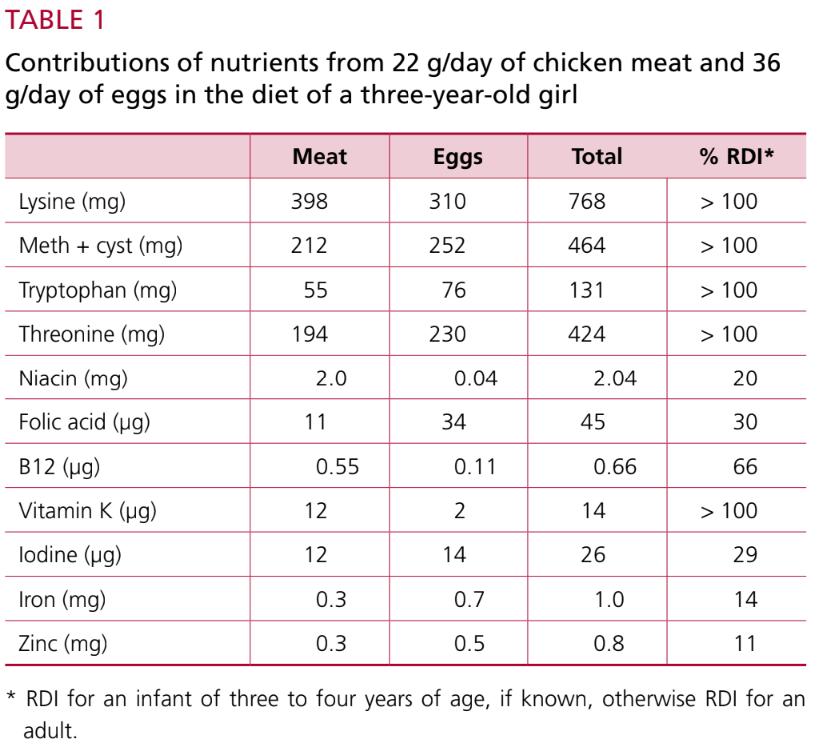



The importance of poultry meat and eggs, especially for children and women
Why poultry meat and eggs are so importantTo illustrate just how important poultry can be in the developing world, this information note examines a typical diet of a three–year-old girl living in Papua New Guinea, weighing about 10 kg and with an energy intake of 4 000 kJ/day. Her diet might consist of a small amount of rice (50 g/day) but mainly sweet potato, taro, yams and cassava. Her family of five keeps a small flock of nine hens and a cockerel. These should produce approximately 12 eggs and one chicken, yielding 780 g of edible meat, each week. This will give each member of the family 22 g of meat a day, and the child receives five of the 12 eggs each week, or 36 g of edible egg per day.
Table 1 shows the daily contribution that the eggs and meat make to the girl’s recommended dietary intake (RDI) of some essential nutrients. These are mostly for a child of three to four years of age, but RDIs have not been determined for people living in developing countries and are likely to be generous (by perhaps 20 percent), especially if “the law of diminishing returns” applies to nutrient utilization, so that a low nutrient intake is used with greater efficiency, particularly from animal products.
The eggs and meat will provide the girl with all the critical amino acids and vitamin K she needs, 30 percent of the RDI for folate, 66 percent for vitamin B12, 30 percent for biotin and 29 percent for iodine.
Iron is especially important and often deficient, particularly in the diet of women in developing countries. It is known that the iron in meat and, to a lesser extent eggs, is highly available, unlike the iron in vegetables; the iron in the chicken meat and eggs in Table 1 is likely to meet more than 14 percent of the girl’s daily requirement.

Folic acid in poultry meat and eggs is especially important during pregnancy
Folic acid deficiency is of major concern in almost all developing countries and has been shown to lead to neural tube defects. These can occur very early in pregnancy, resulting in severe defects of the brain and spinal cord, stillbirths and early child mortality. A recent survey in Uttar Pradesh (India) (Cherian et al., 2005) found that neural tube defects ranged from 3.9 to 8.8 per 1 000 birth – the highest rate in the world. Green leafy vegetables and fruit are good sources of folic acid, but up to half can be lost in cooking. Assuming that she is not a vegetarian, the 45 μg in the meat and eggs shown in Table 1, will provide a pregnant woman with 23 percent of her RDI for folic acid (200 μg/day, although this figure varies widely). The folic acid concentration in eggs can be increased substantially by feeding hens a folic acid-enriched diet.
The family also benefits from the dietary addition of meat and eggs
The family of the infant girl in Table 1 will also benefit through supplementation of their diets with their shares of poultry meat and eggs. Even when only half of the meat and eggs in Table 1 are provided, they will still have a highly beneficial effect on a child by reducing many of the signs associated with a dietary protein deficiency such as low growth, kwashiorkor and poor mental function.
Conclusions
Poultry meat and eggs are widely available, relatively inexpensive and can be of central importance in helping to meet shortfalls in essential nutrients, particularly of impoverished people. The incidence of several common metabolic diseases associated with deficiencies of critical dietary minerals, vitamins and amino acids
can be reduced by the contribution of poultry products rich in all essential nutrients except vitamin C.








